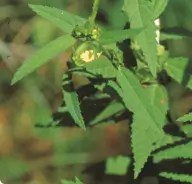Sida aka Wireweed aka Sida rhombifolia, S. acuta, S. spinosa, S. cordifolia, 4 species that can be used interchangeably as a powerful medicine against a wide range of bacterial infections. They grow throughout much of the US.
There are many more Sida species around the world, many used as medicine. Most medicinal studies have been on just two, Sida rhombifolia & S. acuta and are usually the species referenced in medicinal literature.
Both S. acuta and S. rhombifolia are very common where I live. Because studies show subtle difference in the two I mix them together in tincture form.
Just a few of the issues Sida is used to treat: Anemia, Cancers of the blood, Diarrhea, Dysentery, Fevers, Infected wounds, Lyme, Malaria, Systemic staph infections & Tuberculosis.
A short list of specific bacteria Sida is effective against... Aspergillus niger, Bacillus ssp, Entamoeba histolytice, Esherichia coli, Kielsiella pneumonia, Herpes simplex, Listeria innocue, Micrococcus lutens, Morganelia morganli, Salmonella ssp, Shingella dysentariae, Staphylococcus sp.
Sida was brought to the US and cultivated for an industrial purpose. Its stems were used to make brooms. The stem is incredibly tough, hence the name wireweed. To this day it is often found growing around old barns and pastures. It can be up to 3ft tall. Much over 8inches and it’ll choke a lawnmower if you try to mow it, tough stuff.
This year 100’s of plants came up in my chicken pen. I let it grow so I could make a few quarts of tincture.
Other benefits… it’s protein content ranges from 16% to 25%, that’s more protein per ounce than a ribeye steak. Even better, its tasty!
It has one more very important medicinal use… It neutralizes hemotoxin venom. In central and south american it is commonly used to treat pit viper bites in rural areas where antivenom is not available. In particular the bite from the snake Bothrops atox. It’s effective against any hemotoxic venom including black widow and brown recluse spider bites. I have in fact used sida to treat a copperhead bite along with several other plants which I will detail in separate post. As a complex subject it deserves a discussion as a sparate topic.
Sida is a must have plant for any prepper to keep around.
The photos show Sida grows in patches, sometimes quite large. The leaves are alternate, diamond shaped with toothed edges and about 1.5 inches in length. The blooms are very small and yellow. The leaves of Sida acuta are also diamond shaped but much narrower than S. rhombifolia. The last photo is Sida acuta. Also, S. rhombifolia blooms in late June/early July. S. acuta blooms in late August/early September.
I made a 1:2 tincture. This is a high dosage tincture, up to 1/2 Tsp, 4x daily for severe cases so I need a lot of it on hand. When finished these 3-quart jars will produce about 32 ounces of tincture. As with most plants the tincture is good for 12-15 years when stored properly.





There are many more Sida species around the world, many used as medicine. Most medicinal studies have been on just two, Sida rhombifolia & S. acuta and are usually the species referenced in medicinal literature.
Both S. acuta and S. rhombifolia are very common where I live. Because studies show subtle difference in the two I mix them together in tincture form.
Just a few of the issues Sida is used to treat: Anemia, Cancers of the blood, Diarrhea, Dysentery, Fevers, Infected wounds, Lyme, Malaria, Systemic staph infections & Tuberculosis.
A short list of specific bacteria Sida is effective against... Aspergillus niger, Bacillus ssp, Entamoeba histolytice, Esherichia coli, Kielsiella pneumonia, Herpes simplex, Listeria innocue, Micrococcus lutens, Morganelia morganli, Salmonella ssp, Shingella dysentariae, Staphylococcus sp.
Sida was brought to the US and cultivated for an industrial purpose. Its stems were used to make brooms. The stem is incredibly tough, hence the name wireweed. To this day it is often found growing around old barns and pastures. It can be up to 3ft tall. Much over 8inches and it’ll choke a lawnmower if you try to mow it, tough stuff.
This year 100’s of plants came up in my chicken pen. I let it grow so I could make a few quarts of tincture.
Other benefits… it’s protein content ranges from 16% to 25%, that’s more protein per ounce than a ribeye steak. Even better, its tasty!
It has one more very important medicinal use… It neutralizes hemotoxin venom. In central and south american it is commonly used to treat pit viper bites in rural areas where antivenom is not available. In particular the bite from the snake Bothrops atox. It’s effective against any hemotoxic venom including black widow and brown recluse spider bites. I have in fact used sida to treat a copperhead bite along with several other plants which I will detail in separate post. As a complex subject it deserves a discussion as a sparate topic.
Sida is a must have plant for any prepper to keep around.
The photos show Sida grows in patches, sometimes quite large. The leaves are alternate, diamond shaped with toothed edges and about 1.5 inches in length. The blooms are very small and yellow. The leaves of Sida acuta are also diamond shaped but much narrower than S. rhombifolia. The last photo is Sida acuta. Also, S. rhombifolia blooms in late June/early July. S. acuta blooms in late August/early September.
I made a 1:2 tincture. This is a high dosage tincture, up to 1/2 Tsp, 4x daily for severe cases so I need a lot of it on hand. When finished these 3-quart jars will produce about 32 ounces of tincture. As with most plants the tincture is good for 12-15 years when stored properly.





Last edited:



















































